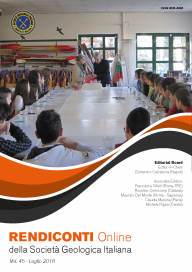
Beach sands of Lipari island, Aeolian archipelago: roundness study
Consuele Morrone (a), Emilia Le Pera (a), Rosanna De Rosa (a) & Kathleen M. Marsaglia (b)
(a) Dipartimento di Biologia, Ecologia e Scienze della Terra (DiBEST), Università della Calabria, via P. Bucci, cubo 15b, 87036, Rende (CS), Italy.
(b) Department of Geological Sciences, California State University, Northridge, California 91330-8266, USA.
Corresponding author e-mail: consuele.morrone@unical.it
DOI: https://doi.org/10.3301/ROL.2018.42
Volume: 45/2018
Pages: 141-146
Abstract
This work focuses on the textural characterization of modern sand supplied from a volcanic island in the Aeolian Archipelago, with particular attention given to the factors that control grain rounding. Twelve beach sands were collected from hightide berms spaced along Lipari’s accessible coastal perimeter. Point-count data were collected using a petrographic microscope with an automated stepper stage. Changes in grain roundness were assessed to evaluate grain resistance to transport
(currents and wave abrasion). A numerical value was assigned to very angular (1), angular (2), sub-angular (3), sub-rounded (4), rounded (5) and well-rounded (6) categories. Analyzed particles are monocrystalline grains of plagioclase (Plag) and pyroxene (Py) and volcanic lithic fragments of Lvl (volcanic lithic with lathwork texture), Lvmi (volcanic lithic with microlitic texture), Lvv (volcanic lithic with vitric texture) and Lvf (volcanic lithic with felsitic texture). The most common roundness category among all the grains from the sampled coastal stretches of Lipari island is 3 (sub-angular, 36,1%), immediately followed by 2 (angular, 28,5%), 4 (sub-rounded, 20,0%), 1 (very angular, 10,1%), 5 (rounded, 4,2%) and lower occurrence of 6 (well rounded, 1,1%). We have also determined that some grain types tend to round more quickly in beach environments, such as plagioclase among the monocrystalline grains and Lvmi among the lithic grains population. Lipari’s beach sands are all better rounded on the eastern side which is the more protected part of the island. Alternatively, the sand grains on the east side of the island have a
longer residence time on the beach.
Keywords
Get Full Text